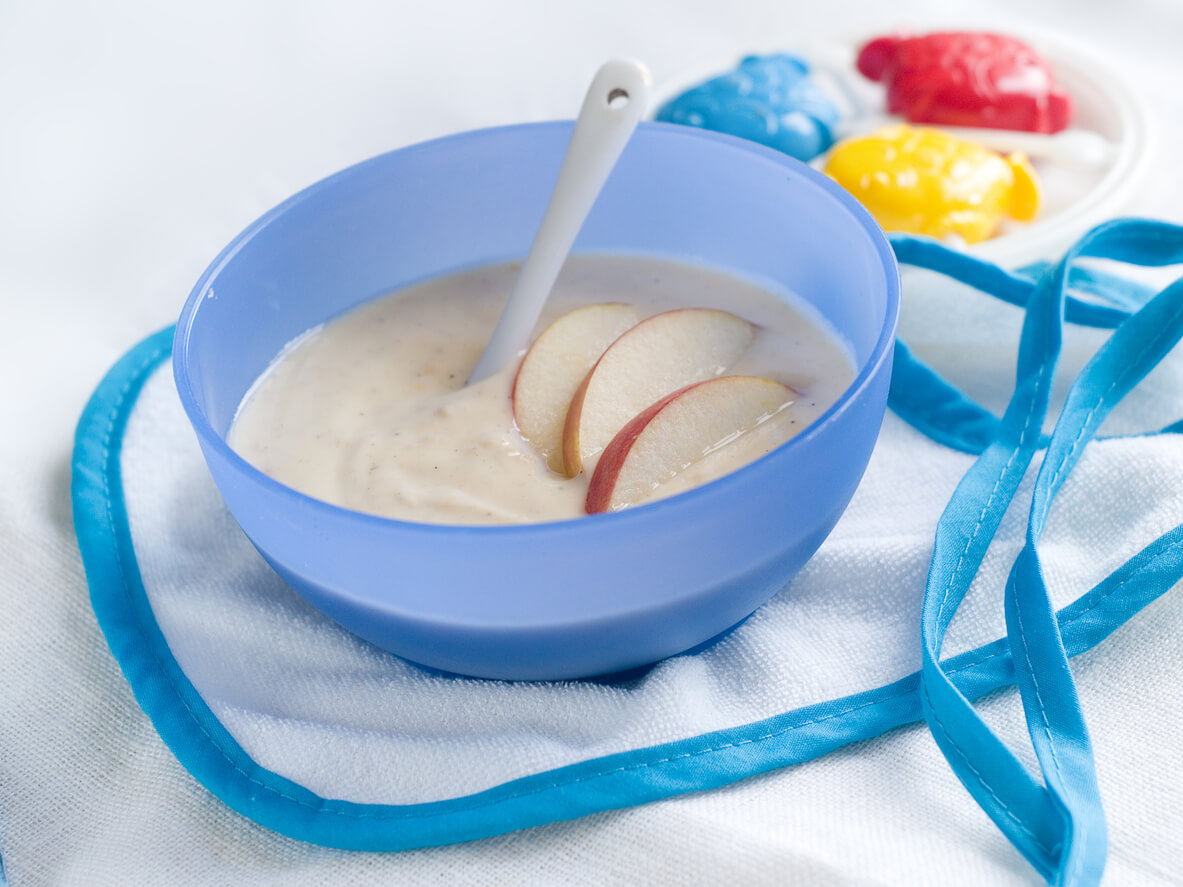7 Pureed Foods for Starting Complementary Feeding
Pureed foods are an ideal approach to starting complementary feeding in babies, as they're both nutritious and practical at the same time.

If your baby has already reached six months of age and is exclusively breastfed, it’s time to start introducing other foods. As they grow, little ones require more energy and nutrients, so they need to add new foods to their diet. So, pureed foods are the ideal food to start complementary feeding, as they’re safe for babies and simple to prepare.
Although nowadays, another form of complementary food has become popular, pureed foods represent a safe source of nutrients for babies. However, it’s important to choose the most nutritious options and those with a low allergy risk to prepare them successfully.
In this article, we’ll suggest seven pureed foods for starting complementary feeding, given their nutritional value, the way they’re prepared, and their low risk. Also, if you have any doubts, don’t forget to consult your pediatrician and nutritionist.
What do health organizations have to say about complementary feeding?
The WHO, in a report from 2023, explains that, at around six months of age, the energy and nutritional needs of a baby are higher than what breast milk provides. Therefore, from this point on, it’s necessary to supplement with new foods.
The Spanish Association of Pediatrics stresses that renal, gastrointestinal, neurological, and immune maturation is necessary to start with new foods. The period of complementary feeding ranges from 6 to 24 months.
What are pureed foods?
Pureed foods that are obtained by cooking certain ingredients in water, such as vegetables or legumes, among others, which are then mashed. Another way is to mix grains with milk or hot water and grind raw foods, such as fruits, cookies, or yogurt.
Learn more:: Cereal Purees for Babies: What You Need to Know
Discover these seven pureed foods to start complementary feeding
When we start complementary feeding, we must ensure that the new foods to be introduced are of high nutritional value. In addition, they shouldn’t represent a risk for the baby when swallowing them. Below, we’ll tell you about some of the best pureed foods for little ones.
1. Avocado and banana puree

This porridge provides babies with natural sugars that are found in bananas and provide energy for their growth. Also, they contain fructooligosaccharides (FOS), which, according to the Spanish Nutrition Foundation, are a type of prebiotic that acts as a nutrient to promote the growth of intestinal bacteria beneficial to health.
At the same time, avocado is a source of monounsaturated fat, such as oleic fatty acid, which characterizes olive oil. This fatty acid is linked to cardiovascular health benefits.
2. Meat porridge
Meats represent the main source of protein and heme iron in the diet. Just a small portion will be enough to complement a child’s protein requirements. However, due to its high protein concentration, it’s important to evaluate if your baby is ready to digest it. In this regard, the most recommended options are ground beef or poultry mixed with skinless tomato puree.
3. Strained carrot
Carrots are one of the favorite vegetables among babies and children, according to health professionals. They contain natural sugars that provide energy for babies and, above all, vitamin A, also known as retinol.
This vitamin develops good visual health, cares for the skin, and strengthens the immune system. The Spanish Association of Pediatrics agrees that babies between 6 and 12 months of age should ingest 500 micrograms of retinol a day. Therefore, a few small portions of strained carrot are enough to cover the recommended intake.
4. Broccoli and potatoes
The first months of complementary feeding are the right time to incorporate valuable vegetables such as broccoli. The USDA nutritional table recognizes the optimal values of 100 grams of this vegetable:
- Carbohydrates: It contributes 6 grams, divided between fiber and sugars such as fructose.
- Insoluble fiber: Broccoli contains 2.5 grams. It prevents constipation.
- Potassium: 300 milligrams, which is useful for the functioning of the kidney, heart, and muscle contraction.
- Folic acid: 65 micrograms. This nutrient is necessary for cell division in the body, especially during growth and development.
- Vitamin C: Broccoli provides almost 92 milligrams. In addition to its antioxidant effect, it strengthens the immune system and fights diseases.
- Lutein and zeaxanthin: It offers 750 micrograms. These are two powerful antioxidant carotenoids that are part of the retina.
It’s advisable to steam broccoli florets to accelerate their softening and keep vitamin C from disintegrating completely. Then, it should be liquefied together with pieces of cooked potato, which will soften its strong flavor. In addition, you can add one teaspoon of butter or 1/4 teaspoon of olive oil to enrich it.
5. Oatmeal with apple

Oatmeal is one of the most recommended cereals for baby food. The USDA shows its high carbohydrate values (70%), which makes it the main source of energy. In addition, its soluble fiber content, such as beta-glucan, has given it a place of honor among other cereals. In this regard, a report by the Spanish Nutrition Foundation comments on the declaration of oats as a healthy food.
For its part, apples, like bananas, provide fructoligosaccharides. In this way, it transports prebiotics to the baby’s intestinal microflora.
Keep reading: Oatmeal Recipes for Babies and Their Benefits
6. Sweet potato porridge
The yellow or orange color of sweet potato gives it away as a source of vitamin A. The fiber it contains improves digestion, while the natural sugars function as a source of energy. A good way to prepare it is to remove the peel and, after wrapping it in aluminum foil, soften it in the oven. Then, puree it and, if desired, strain it.
7. Quinoa porridge
Quinoa is a pseudocereal of ancestral origin and whose nutritional benefits have given it a privileged place among grains and seeds. The minerals it contributes, including zinc, iron, potassium, calcium, and magnesium, cover 30% of a child’s requirements. In addition, its fiber value allows it to be well digested, and its protein value -between 12 and 18%- is a source of nitrogen used for a baby’s growth.
Select the best pureed foods!
There are other pureed foods that are also nutritious and practical, so they can be included in the baby’s complementary feeding. A nutrition professional will provide guidance on which ones to incorporate, as the idea is to diversify meals and add them progressively.
You can combine different foods to enrich them and even add breast milk. As a reminder, we reiterate that breastfeeding is the exclusive and healthiest food during the first 6 months of a baby’s life. And, as the baby grows, we must maintain the criterion of selecting the best foods for their good health.

